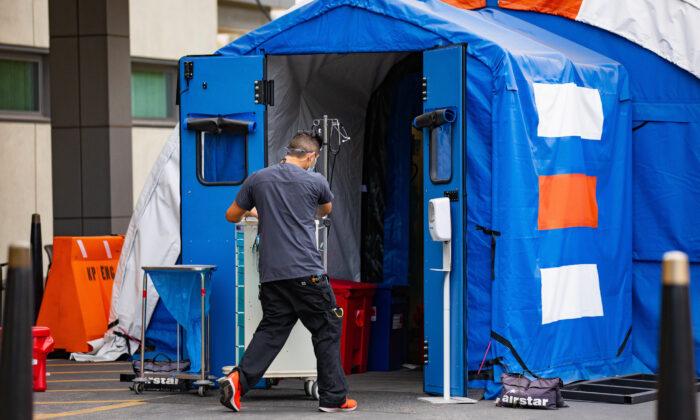SANTA ANA, Calif. (CNS)—Orange County reported a single-day record 4,606 new cases of COVID-19 and 15 additional deaths Dec. 20, bringing the county’s totals to 124,428 cases and 1,775 fatalities.
The county’s record-setting trend of COVID-19 hospitalizations continued, with 1,682—a jump from 1,601 on Dec. 19—and 375 COVID-19 patients in intensive care units (ICU), up from 361 the previous day.
Both are new records—a daily occurrence dating back to early December.
Six of the 15 deaths reported Dec. 20 were residents of skilled nursing facilities, and another six were skilled nursing staff members. The county has logged a total of 632 COVID-19 fatalities at skilled nursing facilities, and another 165 deaths at assisted living facilities.
The county’s ICU bed availability remained zero in the “adjusted” metric, and was 12.1 percent in the unadjusted number. The state created the adjusted metric to reflect the difference in beds available for COVID-19 patients and non-COVID patients.
The county recorded 20,198 COVID-19 tests on Dec. 20 for a total of 1,851,843 to date. There have been 72,627 documented recoveries.
The county is testing 526.8 people per 100,000 on a seven-day average with a seven-day lag, which is an all-time high.
Prior to this month, the record for ICU patients in Orange County was 245 during the mid-July surge. Overall hospitalizations have been breaking records daily since Dec. 2.
Dr. Clayton Chau, the director of the Orange County Health Care Agency (OCHCA) and the county’s chief health officer, issued two orders this week in an attempt to reduce the spread of the virus in nursing homes and to follow suit on quarantine durations recommended by the U.S. Centers for Disease Control and Prevention (CDC).
Chau issued an order Dec. 15 prohibiting communal dining and group activities in residential care facilities for the elderly when a patient or staffer is diagnosed with COVID-19. The group dining and activities can resume after two consecutive rounds of COVID-19 tests of all residents and employees at least a week apart come back negative.
On Dec. 17, Chau also shortened quarantines from 14 days to 10 days to follow the new guidance from the CDC.
Orange County CEO Frank Kim said the order came about after state officials asked the county to help the nursing homes.
“Based on our review, it appeared that in a lot of [the facilities] they were eating together in dining rooms and not taking as many precautions as recommended,” Kim said.
Kim said he was concerned about the rising case counts and hospitalizations.
Beyond ramping up testing and setting up mobile field hospitals to help overflowing medical centers, Kim said, “all you can do is implore people to change their behavior.”
Hospital executives and doctors have told him that “their biggest fear is Christmas,” Kim said.
“They’re looking at the trend and they don’t see the end of the tunnel yet,” Kim said. “They’re concerned. They’re activating their surge plans. Several are requesting mobile hospital units and we’re responding immediately.”
Orange County Supervisor Lisa Bartlett noted how some neighboring counties are seeing double the virus cases that Orange County has and are at zero capacity for patients, so Orange County will likely have to take some of them on.
County officials received a bit of good news when it was discovered that the county received extra doses of the new Pfizer vaccine.
“Some of the vials have extra doses,” Bartlett said. “So we’re getting more doses than anticipated, so that’s a good thing.”
If the hospitals are overwhelmed, then doctors will have to make “difficult choices” when triaging patients, Bartlett said.
“We don’t want to get to that point,” she said. “We want to serve every single individual who comes into the [emergency room].”
The OCHCA this week issued an order suspending the ability of hospitals that take part in the 911 system to request a diversion of ambulances to other medical centers.
Dr. Carl Schultz, the agency’s emergency medical services (EMS) medical director, said emergency rooms have become so overwhelmed due to the COVID-19 surge that “almost all hospitals were going on diversion.”
“If nothing was done, ambulances would soon run out of hospitals that could take their patients,” Schultz said.
“Therefore, we temporarily suspended ambulance diversion. While this will place some additional stress on hospitals, it will spread this over the entire county and help to mitigate the escalating concern of finding hospital destinations for ambulances.
“To the best of our knowledge, this has never happened before.”
The county has rolled out mobile field hospitals to help with the overflow. University of California–Irvine (UC Irvine) Medical Center, Fountain Valley Hospital, and Hoag Memorial Hospital Presbyterian received 50 more beds each, and St. Joseph’s Hospital in Orange got 25 more beds.
Orange County’s adjusted daily case rate per 100,000 rose Dec. 15 from 30.3 the previous week to 42.7, with the positivity rate increasing from 10.6 percent to 13.2 percent. The county’s Health Equity Quartile Positivity Rate, which measures the cases in highly affected, needier parts of the county, rose from 16.2 percent last week to 18.8 percent.
The county has received its first shipment of Pfizer’s COVID-19 vaccine, and county officials are expecting about 32,000 doses of the Moderna vaccine next week.






Friends Read Free